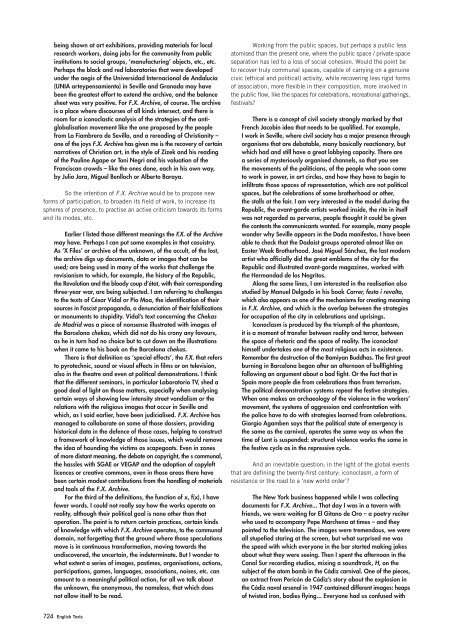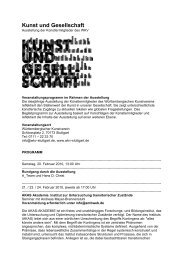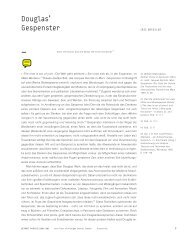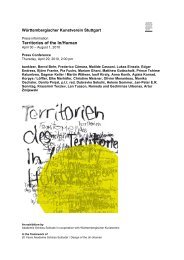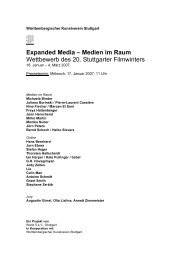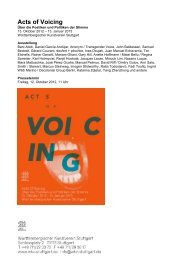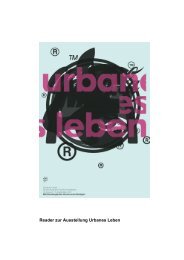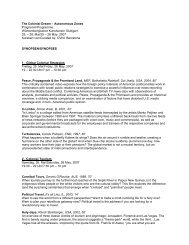English Texts
English Texts
English Texts
Create successful ePaper yourself
Turn your PDF publications into a flip-book with our unique Google optimized e-Paper software.
eing shown at art exhibitions, providing materials for local<br />
research workers, doing jobs for the community from public<br />
institutions to social groups, ‘manufacturing’ objects, etc., etc.<br />
Perhaps the black and red laboratories that were developed<br />
under the aegis of the Universidad Internacional de Andalucía<br />
(UNIA arteypensamiento) in Seville and Granada may have<br />
been the greatest effort to extend the archive, and the balance<br />
sheet was very positive. For F.X. Archive, of course. The archive<br />
is a place where discourses of all kinds intersect, and there is<br />
room for a iconoclastic analysis of the strategies of the antiglobalisation<br />
movement like the one proposed by the people<br />
from La Fiambrera de Sevilla, and a rereading of Christianity –<br />
one of the joys F.X. Archive has given me is the recovery of certain<br />
narratives of Christian art, in the style of Zizek and his reading<br />
of the Pauline Agape or Toni Negri and his valuation of the<br />
Franciscan crowds – like the ones done, each in his own way,<br />
by Julio Jara, Miguel Benlloch or Alberto Baraya.<br />
So the intention of F.X. Archive would be to propose new<br />
forms of participation, to broaden its field of work, to increase its<br />
spheres of presence, to practise an active criticism towards its forms<br />
and its modes, etc.<br />
Earlier I listed those different meanings the F.X. of the Archive<br />
may have. Perhaps I can put some examples in that casuistry.<br />
As ‘X Files’ or archive of the unknown, of the occult, of the lost,<br />
the archive digs up documents, data or images that can be<br />
used; are being used in many of the works that challenge the<br />
revisionism to which, for example, the history of the Republic,<br />
the Revolution and the bloody coup d’état, with their corresponding<br />
three-year war, are being subjected. I am referring to challenges<br />
to the texts of César Vidal or Pío Moa, the identification of their<br />
sources in Fascist propaganda, a denunciation of their falsifications<br />
or monuments to stupidity. Vidal’s text concerning the Chekas<br />
de Madrid was a piece of nonsense illustrated with images of<br />
the Barcelona chekas, which did not do his crony any favours,<br />
as he in turn had no choice but to cut down on the illustrations<br />
when it came to his book on the Barcelona chekas.<br />
There is that definition as ‘special effects’, the F.X. that refers<br />
to pyrotechnic, sound or visual effects in films or on television,<br />
also in the theatre and even at political demonstrations. I think<br />
that the different seminars, in particular Laboratorio TV, shed a<br />
good deal of light on those matters, especially when analysing<br />
certain ways of showing low intensity street vandalism or the<br />
relations with the religious images that occur in Seville and<br />
which, as I said earlier, have been judicialised. F.X. Archive has<br />
managed to collaborate on some of those dossiers, providing<br />
historical data in the defence of those cases, helping to construct<br />
a framework of knowledge of those issues, which would remove<br />
the idea of hounding the victims as scapegoats. Even in zones<br />
of more distant meaning, the debate on copyright, the s communal,<br />
the hassles with SGAE or VEGAP and the adoption of copyleft<br />
licences or creative commons, even in those areas there have<br />
been certain modest contributions from the handling of materials<br />
and tools of the F.X. Archive.<br />
For the third of the definitions, the function of x, f(x), I have<br />
fewer words. I could not really say how the works operate on<br />
reality, although their political goal is none other than that<br />
operation. The point is to return certain practices, certain kinds<br />
of knowledge with which F.X. Archive operates, to the communal<br />
domain, not forgetting that the ground where those speculations<br />
move is in continuous transformation, moving towards the<br />
undiscovered, the uncertain, the indeterminate. But I wonder to<br />
what extent a series of images, pastimes, organisations, actions,<br />
participations, games, languages, associations, noises, etc. can<br />
amount to a meaningful political action, for all we talk about<br />
the unknown, the anonymous, the nameless, that which does<br />
not allow itself to be read.<br />
Working from the public spaces, but perhaps a public less<br />
atomised than the present one, where the public space / private space<br />
separation has led to a loss of social cohesion. Would the point be<br />
to recover truly communal spaces, capable of carrying on a genuine<br />
civic (ethical and political) activity, while recovering less rigid forms<br />
of association, more flexible in their composition, more involved in<br />
the public flow, like the spaces for celebrations, recreational gatherings,<br />
festivals?<br />
There is a concept of civil society strongly marked by that<br />
French Jacobin idea that needs to be qualified. For example,<br />
I work in Seville, where civil society has a major presence through<br />
organisms that are debatable, many basically reactionary, but<br />
which had and still have a great lobbying capacity. There are<br />
a series of mysteriously organised channels, so that you see<br />
the movements of the politicians, of the people who soon come<br />
to work in power, in art circles, and how they have to begin to<br />
infiltrate those spaces of representation, which are not political<br />
spaces, but the celebrations of some brotherhood or other,<br />
the stalls at the fair. I am very interested in the model during the<br />
Republic, the avant-garde artists worked inside, the rite in itself<br />
was not regarded as perverse, people thought it could be given<br />
the contents the communicants wanted. For example, many people<br />
wonder why Seville appears in the Dada manifestos. I have been<br />
able to check that the Dadaist groups operated almost like an<br />
Easter Week Brotherhood. José Miguel Sánchez, the last modern<br />
artist who officially did the great emblems of the city for the<br />
Republic and illustrated avant-garde magazines, worked with<br />
the Hermandad de los Negritos.<br />
Along the same lines, I am interested in the realisation also<br />
studied by Manuel Delgado in his book Carrer, festa i revolta,<br />
which also appears as one of the mechanisms for creating meaning<br />
in F.X. Archive, and which is the overlap between the strategies<br />
for occupation of the city in celebrations and uprisings.<br />
Iconoclasm is produced by the triumph of the phantasm,<br />
it is a moment of transfer between reality and terror, between<br />
the space of rhetoric and the space of reality. The iconoclast<br />
himself undertakes one of the most religious acts in existence.<br />
Remember the destruction of the Bamiyan Buddhas. The first great<br />
burning in Barcelona began after an afternoon of bullfighting<br />
following an argument about a bad fight. Or the fact that in<br />
Spain more people die from celebrations than from terrorism.<br />
The political demonstration systems repeat the festive strategies.<br />
When one makes an archaeology of the violence in the workers’<br />
movement, the systems of aggression and confrontation with<br />
the police have to do with strategies learned from celebrations.<br />
Giorgio Agamben says that the political state of emergency is<br />
the same as the carnival, operates the same way as when the<br />
time of Lent is suspended: structural violence works the same in<br />
the festive cycle as in the repressive cycle.<br />
And an inevitable question; in the light of the global events<br />
that are defining the twenty-first century: iconoclasm, a form of<br />
resistance or the road to a ‘new world order’?<br />
The New York business happened while I was collecting<br />
documents for F.X. Archive... That day I was in a tavern with<br />
friends, we were waiting for El Gitano de Oro – a poetry reciter<br />
who used to accompany Pepe Marchena at times – and they<br />
pointed to the television. The images were tremendous, we were<br />
all stupefied staring at the screen, but what surprised me was<br />
the speed with which everyone in the bar started making jokes<br />
about what they were seeing. Then I spent the afternoon in the<br />
Canal Sur recording studios, mixing a soundtrack, H, on the<br />
subject of the atom bomb in the Cádiz carnival. One of the pieces,<br />
an extract from Pericón de Cádiz’s story about the explosion in<br />
the Cádiz naval arsenal in 1947 contained different images: heaps<br />
of twisted iron, bodies flying... Everyone had us confused with<br />
724 <strong>English</strong> <strong>Texts</strong>


